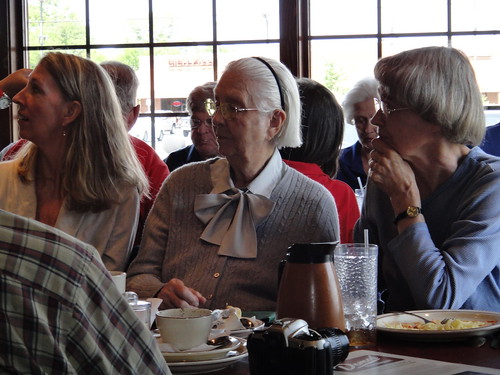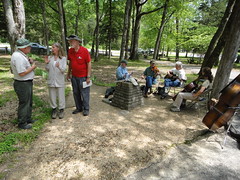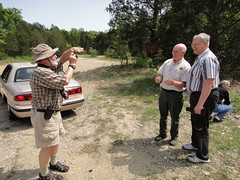 Gretchen digging the potatoes she’s selling today at
Downtown Valdosta Farm Days.
Gretchen digging the potatoes she’s selling today at
Downtown Valdosta Farm Days.
Look at the roots on that thing!
Hundreds of pounds of potatoes: Continue reading
 Gretchen digging the potatoes she’s selling today at
Downtown Valdosta Farm Days.
Gretchen digging the potatoes she’s selling today at
Downtown Valdosta Farm Days.
Look at the roots on that thing!
Hundreds of pounds of potatoes: Continue reading
Increase your income and your yields with traditional farming methods? That’s what’s happening in India.
Nishika Patel blogged 11 May 2011 in The Guardian, Organic farming – India’s future perfect?
How did this happen?India’s struggling farmers are starting to profit from a budding interest in organic living. Not only are the incomes of organic farmers soaring – by 30% to 200%, according to organic experts – but their yields are rising as the pesticide-poisoned land is repaired through natural farming methods.
Organic farming only took off in the country about seven years ago. Farmers are turning back to traditional farming methods for a number of reasons.Continue readingFirst, there’s a 10% to 20% premium
 You can’t dig
just one.
Here’s how Gretchen
digs potatoes with a shovel:
You can’t dig
just one.
Here’s how Gretchen
digs potatoes with a shovel:
Heavy, as in more than 40 pounds of potatoes:
Yes, that’s a bathroom scale; only thing we had for something that heavy.
She learned all this from Terry Davis. He and I planted those potatoes. Pictures and videos by John S. Quarterman, Lowndes County, Georgia, 5 May 2011.
-jsq
 We already know that the long trend in growth in farmers markets
continued this year as
more farmers markets opened,
including even winter farmers markets,
such as
Indy Farmers Market in Indianapolis:
We already know that the long trend in growth in farmers markets
continued this year as
more farmers markets opened,
including even winter farmers markets,
such as
Indy Farmers Market in Indianapolis:
And it’s not just about food, it’s about the local food chain and economy, and “in that food chain you find relationships.”
Henderson said she wasn’t looking to start a business when she started Indy Winter Farmers’ Market. Her efforts, she joked, were more about making Indianapolis into a place she wanted to live.But on that first day at 25th and Central, with people lined up outside the door, she realized her goals were similar to those of many others in the community. Her market and others like it, she explained, are about more than food.
“It’s not just about the market,” she said. “We should be proud to be Indiana, the Heartland, a farm state.”
-jsq
Farmers markets are an integral part of the urban/farm linkage and have continued to rise in popularity, mostly due to the growing consumer interest in obtaining fresh products directly from the farm. Farmers markets allow consumers to have access to locally grown, farm fresh produce, enables farmers the opportunity to develop a personal relationship with their customers, and cultivate consumer loyalty with the farmers who grows the produce. Direct marketing of farm products through farmers markets continues to be an important sales outlet for agricultural producers nationwide. As of mid-2010, there were 6,132 farmers markets operating throughout the U.S. This is a 16 percent increase from 2009.USDA is updating their directory now.
-jsq
His personal goal:Conventional farmers use chemical fertilizers made from fossil fuels. Then they mess with the dirt to make the plants grow. They do this because they’ve stripped the soil from all nutrients from growing the same crop over and over again. Next more harmful chemicals are sprayed on fruits and vegetables. Like pesticides and herbicides to kill weeds and bugs. When it rains, these chemicals seep into the ground, or rise into our waterways, poisoning our water, too.
A while back, I wanted to be an NFL footall player.He’s got a turn of phrase:
I decided I’d rather be an organic farmer instead.
[applause]
That way I can have a greater impact on the world.
We can either pay the farmer, or we can pay the hospital.
-jsq
And that’s plus all sorts of evidence about other ill effects of glysophate, including lower IQ in children, and Roundup-Ready crops themselves causing organ disruptions. All that plus the very real risk of the genetically modified crops having unpredicted effects. There’s much more.Huber was unavailable to respond to media inquiries in the weeks following the leak, and thus unable to defend himself when several colleagues from Purdue publicly claiming to refute his accusations about Monsanto’s widely used herbicide Roundup (glyphosate) and Roundup Ready crops. When his letter was finally acknowledged by the mainstream media, it was with titles like “Scientists Question Claims in Biotech Letter,” noting that the letter’s popularity on the internet “has raised concern among scientists that the public will believe his unsupported claim is true.”
Now, Huber has finally spoken out, both in a second letter, sent to “a wide number of individuals worldwide” to explain and back up his claims from his first letter, and in interviews. While his first letter described research that was not yet complete or published, his second letter cited much more evidence about glyphosate and genetically engineered crops based on studies that have already been published in peer-reviewed journals.
 Could this silence of the press be because
only five companies own more than half of all the media in the U.S.?
Let’s not forget the legal system is also complicit,
given the
Fox-can-lie case.
Could this silence of the press be because
only five companies own more than half of all the media in the U.S.?
Let’s not forget the legal system is also complicit,
given the
Fox-can-lie case.
So what can you do? vote at the checkout counter. Buy local and organic. And of course bug your elected officials about doing something about it.
-jsq

Kim Cleary Sadler,
Assistant Professor of Biology at Middle Tennessee State University
and co-Director of the
Center for Cedar Glade Studies.
(Student of
Thomas “Tom” Ellsworth Hemmerly, who was teaching and couldn’t come.)
Dr. Elsie Quarterman, Professor Emerita of Plant Ecology, Vanderbilt University
Carol C. Baskin, Professor of Biology, University of Kentucky
 There were classes, botany walks, owl hoots, and musicians.
Here’s the schedule.
It was sunny this year,
unlike last year’s great flood.
Next year, you should come!
Get out of town, take a walk in the glades.
There were classes, botany walks, owl hoots, and musicians.
Here’s the schedule.
It was sunny this year,
unlike last year’s great flood.
Next year, you should come!
Get out of town, take a walk in the glades.
 Elsie got a guided tour, with
Tennessee State Naturalist Emeritus Mack Pritchard
and his successor Randy Hedgepath.
Here they are with Elsie’s nephew Patrick Quarterman,
while Gretchen Quarterman photographs a glade.
Elsie got a guided tour, with
Tennessee State Naturalist Emeritus Mack Pritchard
and his successor Randy Hedgepath.
Here they are with Elsie’s nephew Patrick Quarterman,
while Gretchen Quarterman photographs a glade.
 Here
State Naturalist Randy Hedgepath
consults with Dr. Quarterman about identification of a cedar glade plant.
Here
State Naturalist Randy Hedgepath
consults with Dr. Quarterman about identification of a cedar glade plant.
Elsie got out of the car to look at this one with Randy and Ann Quarterman: Continue reading
Would people really want to eat CAFO chicken, beef, or pork if they knew it came from animals that are kept in pens so small they can’t move and fed antibiotics constantly to keep them from dying of diseases they give each other from standing in their own feces?A supermarket shopper buying hamburger, eggs or milk has every reason, and every right, to wonder how they were produced. The answer, in industrial agriculture, is “behind closed doors,” and that’s how the industry wants to keep it. In at least three states — Iowa, Florida, and Minnesota — legislation is moving ahead that would make undercover investigations in factory farms, especially filming and photography, a crime. The legislation has only one purpose: to hide factory-farming conditions from a public that is beginning to think seriously about animal rights and the way food is produced.
Also, I’m a Farm Bureau members, but this makes me ill:
And they are supported by the big guns of industrial agriculture: Monsanto, the Farm Bureau, the associations that represent pork producers, dairy farmers and cattlemen, as well as poultry, soybean, and corn growers.Farming used to be something to be proud of, not something to hide.
-jsq